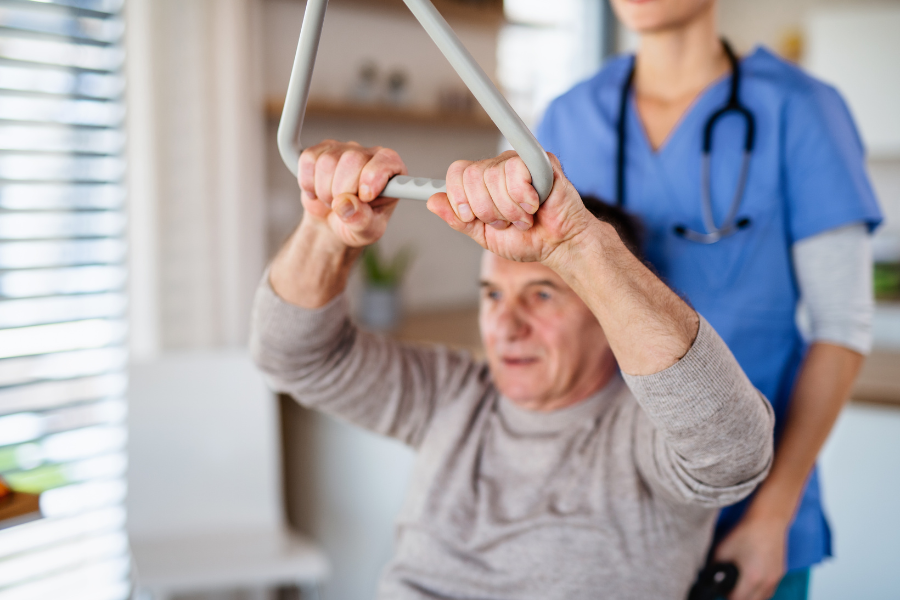A single concussion has the ability to cause life-changing and lasting impacts. Even the slightest brain injury can cause severe damage or even death.
If you see someone with two broken arms then you understand immediately their deficits. But with brain injury, the problems are locked deep inside and they have to be teased out with therapy to uncover a clear path to recovery.[vc_row][vc_column][/vc_column][/vc_row][vc_row][vc_column][vc_column_text]
 Brain injury is an invisible disability.
Brain injury is an invisible disability.
There are 3.2 million Americans living with a long-term disability after being hospitalized with a brain injury. This number from the CDC doesn’t include the volume of people who never receive any medical help at all which was estimated to be close to 10 million every year.
Leading Causes of Traumatic Brain Injury
- 40% Falls
- 14% Motor Vehicle Accidents
- 16% Being Struck
- 11% Assaults
- 19% Other: includes blasts of active duty military
[/vc_column_text][/vc_column][/vc_row][vc_row][vc_column][/vc_column][/vc_row][vc_row][vc_column][vc_column_text]All the everyday injuries add up like being tackled at a high school football game or falling off a bicycle. They build upon deficits and can drastically alter people’s lives.
One of the most challenging roles that a physical therapist can take on is assisting the traumatic brain injured patient because there is usually more than what meets the eye initially.
There will most often times be secondary impairments and neurological deficits.
Physical Therapy’s goal is to improve coordination, balance, and strength. A Physical Therapist will help a patient to engage their muscles to increase flexibility and range of motion.
PT’s are also trained to relieve pain as well as strengthen physical abilities. They help a patient recover from impairments and provide pain-free mobility.
Physical Therapy treats brain disorders by strengthening the body. PT is essential to brain injury rehabilitation because it helps patients gain perceptual, behavioral, cognitive, visual, and neuromuscular tools through movement, activities, and function.
PT’s also help instruct family and caregivers for better overall management of brain injury deficits (prevent falls, accidents and injury due to decreased balance and vestibular functions that’s caused by the brain injury deficits).[/vc_column_text][/vc_column][/vc_row][vc_row][vc_column][/vc_column][/vc_row][vc_row][vc_column][vc_column_text]
Different PT Techniques:
- Exercises for recovery and circulation
- Stretching to improve flexibility
- Ultrasound to relieve pain
- Electrical stimulation
- Hot/cold packs
- Training for wheelchairs, crutches, etc.
[/vc_column_text][/vc_column][/vc_row][vc_row][vc_column][/vc_column][/vc_row][vc_row][vc_column][vc_column_text]
 Neurodevelopmental Treatment
Neurodevelopmental Treatment
Physical Therapist work with the soft tissue for mobilization and range of motion early on to maintain joint integrity and prevent set backs. PT’s also help instruct family and caregivers for better overall management of brain injury deficits.
PT’s utilize neurodevelopmental treatment for traumatic brain injury patients. Neurodevelopmental treatment uses postural control for learning skills and activities are chosen in terms of relevancy specifically for the patient. The treatment will varied in difficulty but normal movement patterns are encouraged.
Balance and Coordination
Because of balance and coordination deficits, prevention of falls is an important goal of physical therapy. Evaluation of lifestyle is critical to help identify dangerous situations for brain injured patients. Walking and independence is the number one goals for brain injury patients but falling is the number one fear.[/vc_column_text][/vc_column][/vc_row][vc_row][vc_column][/vc_column][/vc_row][vc_row][vc_column][vc_column_text]
As a part of the multidisciplinary team, the physical therapist
- Performs evaluations
- Makes recommendations for therapy
- Formulates and implements treatment plans
- Works with other treatment team members
- Provides patient and family education and training
- Makes community access and mobility possible
- Assesses assistive devices
- Collaborates with other medical personnel
- Obtains necessary mobility tools
Physical Therapists work to improve physical disabilities and restore normal movement but the most important goal for the brain-injured patient is independence.
Because each person and environment is different and no two brain injuries are alike, a PT cannot do a cookie-cutter approach with treatment. Each plan for patient care is individualized. The goal is to carry over physical therapy to improve the quality of real-life and help people function again in the real world.[/vc_column_text][/vc_column][/vc_row]



